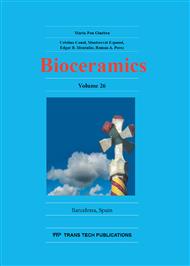p.137
p.143
p.151
p.156
p.160
p.166
p.173
p.179
p.184
Fabrication of Bioactive Polylactic Acid Composite Formed by 3D Printer
Abstract:
We precipitated Apatite Nucleus (AN) by raising pH of SBF. We mixed various concentration of AN in polylactic acid (PLA) and pressed by uniaxial press and cold isostatic press. We investigated the effect of AN concentration on bioactivity. We fabricated composite of PLA and AN configurating the shape by using 3D printer. The composite showed high bioactivity.
Info:
Periodical:
Pages:
160-165
Citation:
Online since:
November 2014
Authors:
Keywords:
Price:
Сopyright:
© 2015 Trans Tech Publications Ltd. All Rights Reserved
Share:
Citation:


